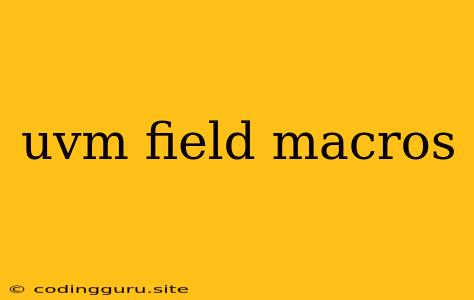Understanding and Using UVM Field Macros
The Universal Verification Methodology (UVM) is a widely adopted standard for verification methodologies in the realm of hardware design. It offers a powerful set of features to efficiently and effectively verify complex hardware designs. Among these features, UVM field macros play a crucial role in simplifying and enhancing the development of testbenches.
What are UVM Field Macros?
UVM field macros are pre-defined macros that provide a convenient way to access and manipulate data fields within UVM objects. These macros are primarily used in the context of UVM sequences and UVM sequences items, where they offer a structured and robust way to access and modify data fields.
Why Use UVM Field Macros?
There are compelling reasons to use UVM field macros in your UVM testbenches:
- Abstraction: UVM field macros abstract away the details of how data is accessed and manipulated, allowing you to focus on the logic of your tests.
- Readability: They enhance code readability by providing clear and concise syntax for accessing data fields.
- Maintainability: UVM field macros improve code maintainability. Changes in data structures can be easily propagated throughout the testbench by modifying the macro definitions.
- Flexibility: UVM field macros support both direct and indirect access to data fields, offering flexibility in how you interact with the data.
- Error Detection: UVM field macros help detect potential errors in your testbenches by providing type checking and compile-time verification.
Common UVM Field Macros
Let's delve into some of the most frequently used UVM field macros:
1. uvm_field_int():
- This macro is used to define an integer field within a UVM sequence item.
- It requires a name for the field, its data type (integer), and its default value.
- Example:
class my_seq_item extends uvm_sequence_item;
uvm_field_int(int_value, UVM_FIELD_DEFAULT);
endclass
2. uvm_field_enum():
- This macro defines an enumeration field within a UVM sequence item.
- It requires a name for the field, its data type (enumeration), and its default value.
- Example:
typedef enum { STATE_IDLE, STATE_ACTIVE, STATE_ERROR } my_state;
class my_seq_item extends uvm_sequence_item;
uvm_field_enum(state, my_state, STATE_IDLE);
endclass
3. uvm_field_string():
- This macro defines a string field within a UVM sequence item.
- It requires a name for the field, its data type (string), and its default value.
- Example:
class my_seq_item extends uvm_sequence_item;
uvm_field_string(string_value, UVM_FIELD_DEFAULT);
endclass
4. uvm_field_object():
- This macro defines an object field within a UVM sequence item.
- It requires a name for the field, its data type (object), and its default value.
- Example:
class my_seq_item extends uvm_sequence_item;
uvm_field_object(my_object, my_object_type, UVM_FIELD_DEFAULT);
endclass
5. uvm_field_array():
- This macro defines an array field within a UVM sequence item.
- It requires a name for the field, its data type (array), and its default value.
- Example:
class my_seq_item extends uvm_sequence_item;
uvm_field_array(int_array, int, 10, UVM_FIELD_DEFAULT);
endclass
6. uvm_field_struct():
- This macro defines a struct field within a UVM sequence item.
- It requires a name for the field, its data type (struct), and its default value.
- Example:
typedef struct packed {
int data1;
int data2;
} my_struct;
class my_seq_item extends uvm_sequence_item;
uvm_field_struct(my_struct_field, my_struct, UVM_FIELD_DEFAULT);
endclass
7. uvm_field_bit():
- This macro defines a bit field within a UVM sequence item.
- It requires a name for the field, its data type (bit), and its default value.
- Example:
class my_seq_item extends uvm_sequence_item;
uvm_field_bit(bit_field, UVM_FIELD_DEFAULT);
endclass
8. uvm_field_logic():
- This macro defines a logic field within a UVM sequence item.
- It requires a name for the field, its data type (logic), and its default value.
- Example:
class my_seq_item extends uvm_sequence_item;
uvm_field_logic(logic_field, UVM_FIELD_DEFAULT);
endclass
Accessing and Modifying Fields
UVM field macros provide a convenient way to access and modify data fields within UVM sequence items. To access a field, use the get_field_by_name() function and specify the field name as an argument. To modify a field, use the set_field_by_name() function and specify the field name and the new value.
Example:
class my_seq_item extends uvm_sequence_item;
uvm_field_int(int_value, UVM_FIELD_DEFAULT);
uvm_field_string(string_value, UVM_FIELD_DEFAULT);
function void print_fields();
$display("int_value: %0d", get_field_by_name("int_value").value);
$display("string_value: %s", get_field_by_name("string_value").value);
endfunction
endclass
class my_sequence extends uvm_sequence;
function void body();
my_seq_item item = my_seq_item::type_id::create("item");
item.set_field_by_name("int_value", 10);
item.set_field_by_name("string_value", "Hello");
item.print_fields();
endfunction
endclass
Best Practices for Using UVM Field Macros
- Use descriptive field names. This enhances code readability and maintainability.
- Avoid unnecessary macros. Define only those fields that are essential for your testbench.
- Use default values appropriately. Set default values that make sense for the data type and the context of the field.
- Document your macros. Provide clear comments to explain the purpose and usage of each macro.
Conclusion
UVM field macros are a valuable tool for developing robust and maintainable UVM testbenches. They provide a structured and convenient way to access and manipulate data fields within UVM sequence items, leading to improved code readability, flexibility, and error detection. By understanding and effectively utilizing these macros, you can significantly streamline your verification efforts and enhance the quality of your hardware designs.
